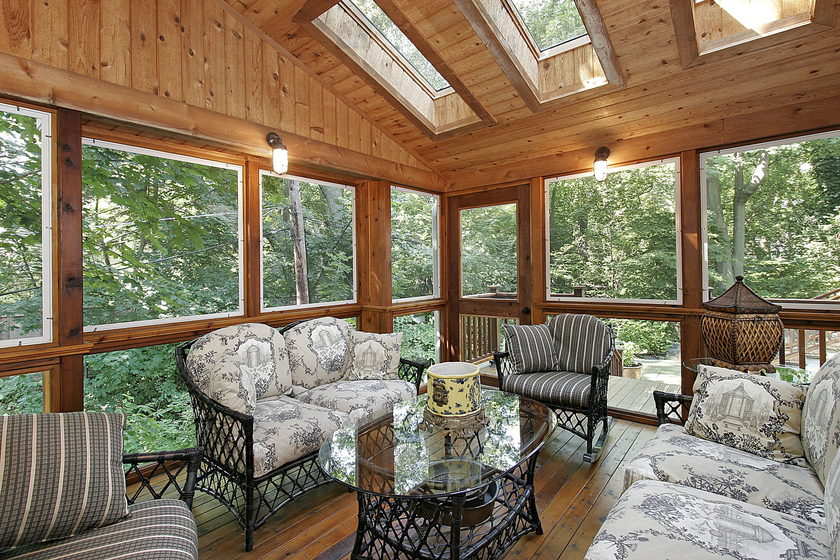A sunroom is a wonderful addition that can transform any home into a bright and relaxing space, perfect for unwinding or spending quality time with family. If you’ve been considering maximizing your living space, choosing to add a sunroom offers beauty and functionality.
This guide will help you manage the important decisions and steps, from selecting the right materials to maintaining year-round comfort. By the end, you’ll be well-prepared to make your dream sunroom a reality.
Why Add a Sunroom?
Adding a sunroom enhances your home’s aesthetic appeal and increases its value and usability. A sunroom can serve as a year-round retreat, an entertaining space, or even a home office bathed in natural light. Its versatility makes it a worthwhile investment for any homeowner looking to expand their living area with style and comfort.

Deciding the Right Location for Your Sunroom
Typically, sunrooms are built off the back or side of a home. However, the choice depends on the space available and the direction of sunlight. A south-facing sunroom maximizes light throughout the day. Meanwhile, an east-facing one captures morning light. Privacy and access should also be considered so that the space connects to your home for ease of use.
Choosing Between Prefab and Custom-Built Sunrooms
Prefabricated sunrooms are generally quicker to install and more affordable. Hence, they are ideal for those seeking a simple solution. However, custom-built sunrooms come with the advantage of being customized to your specific needs and design preferences.
While they require more time and budget, custom sunrooms provide flexibility in design and materials. They can also perfectly complement your home’s aesthetic.
Understanding Building Permits for Sunroom Construction
Building permits allow your sunroom to meet all safety and zoning regulations. Skipping this step can lead to costly fines. Contacting your local building department will help you understand the specific requirements for your area. Remember that permits often cover structural, electrical, and energy efficiency aspects. Therefore, gathering all relevant documents beforehand will make the process smoother.
In some cases, hiring a contractor who understands the permitting process can save time and effort. Contractors are familiar with local codes and can handle the application process on your behalf. Make sure to ask about their experience with sunroom projects and permits to avoid any delays. This approach guarantees that every stage of construction is fully compliant with regulations, from the foundation to the finishing touches.
Selecting the Right Sunroom Design for Your Home
Sunrooms come in various designs, from traditional glass conservatories to more modern structures. Choosing the right design depends on how you plan to use the space and the architectural style of your home.
A full-glass sunroom might be ideal for bringing in maximum sunlight. Meanwhile, designs that incorporate partial walls can provide more privacy and insulation. Your sunroom should complement the rest of your home to create a cohesive and attractive living space.
Evaluating Different Material Options for Sunrooms
Aluminum is a popular choice for framing due to its strength and resistance to corrosion. Vinyl is another good low-maintenance option, as it doesn’t warp or fade.
While more traditional and beautiful, wood requires more upkeep to protect it from the elements. Each material has advantages and costs. Hence, it’s important to balance durability, maintenance, and aesthetic appeal when selecting.
Polycarbonate panels and glass are common roof options. Polycarbonate is lightweight and offers good insulation, making it suitable for year-round use. While heavier, glass allows maximum light but can be more expensive to install.
Double-glazed glass is recommended for better insulation and reduced energy costs. Whether you prioritize cost or functionality, evaluating material options carefully will help you make the right decision for your home.
Insulation Choices for Year-Round Sunroom Comfort
High-quality insulation can keep your space warm in the winter and cool in the summer if you live in an area with extreme temperatures.
Insulating the roof and walls with energy-efficient materials like foam boards or spray insulation will help regulate the temperature inside the sunroom. Adding insulated flooring can improve comfort and make the space more usable in colder months. Insulation creates a cozy retreat no matter the season.
Choosing Energy-Efficient Windows for Your Sunroom
Windows are the focal point of any sunroom. Selecting energy-efficient options is key to maintaining a comfortable temperature. Double or triple-pane windows with low-emissivity (Low-E) coatings will reflect heat while allowing natural light to flood the space.
These windows also help reduce energy costs by preventing heat loss in the winter and minimizing heat gain in the summer. The right choice of windows enhances comfort and improves your home’s overall energy efficiency.
Comparing 3-season and 4-season Sunroom Costs
The costs for building a sunroom can vary greatly depending on whether you opt for a 3-season or 4-season model. A 3-season sunroom is typically less expensive, as it’s designed for use during spring, summer, and fall. It generally has thinner walls and less insulation.
On the other hand, a 4-season sunroom is built for year-round use and requires better insulation, energy-efficient windows, and often heating or cooling systems. While more expensive, a 4-season sunroom provides greater comfort and usability throughout the year.
Determining the Best Heating and Cooling Solutions
Underfloor heating or a dedicated heat pump can maintain warmth without taking up too much space. Radiant heaters are also an efficient choice for keeping the area cozy during colder months.
When it comes to cooling, ceiling fans or a small air conditioning unit can circulate air effectively. They help the room stay pleasant in hot weather. Choosing energy-efficient systems will keep utility costs low.
Combining heating and cooling systems may be necessary to keep the space comfortable in extreme climates. Ductless mini-split systems offer both heating and cooling. For that reason, they are a popular choice for their versatility. These systems allow easy sunroom temperature control without extensive installation work. They are ideal for sunrooms with limited wall space for vents or ducts.
Deciding on Flooring Options for Your Sunroom
Tile flooring is a popular option due to its durability and easy maintenance, especially in spaces that experience a lot of foot traffic. Hardwood flooring can add warmth and elegance to your sunroom but may require more care in humid environments.
Vinyl or laminate flooring is an affordable and comfortable option. It brings the look of wood or tile without the high cost or maintenance.
Working with Contractors for Expert Sunroom Installation
Contractors bring expertise and efficiency to the project. They often complete the build more quickly and make sure it meets local building codes.
While more expensive, hiring professionals can save time and prevent potential mistakes. If you have the necessary skills and experience, a DIY sunroom can be a rewarding project that saves on labor costs. Nevertheless, it won’t come with the professional expertise of certified contractors who bring durability and compliance.
Considering Lighting and Electrical Needs for Sunrooms
Installing overhead lights or wall sconces can provide adequate illumination without overwhelming the room’s natural beauty.
Dimmable lighting or adding floor lamps and string lights can add warmth for those who want to create a cozy ambiance. It’s also important to consider electrical outlets for appliances like fans or entertainment systems. Make an effort to equip your sunroom with modern conveniences.
Understanding Maintenance Requirements for Your Sunroom
Maintaining your sunroom is relatively simple but important to maintain its longevity. Regular cleaning of the windows inside and out will help preserve the room’s clarity and light. If your sunroom features wooden elements, periodic treatments or sealing will be necessary to protect against moisture damage.
Routine inspections for potential leaks or drafts after extreme weather will help you identify areas that need repairs before they worsen. Keeping up with maintenance can let your sunroom remain a beautiful and functional space for years.
Some sunrooms may require more maintenance. This will depend on the materials used. Aluminum and vinyl sunrooms are low-maintenance and can be cleaned with simple soap and water.
However, sunrooms with wooden frames may need more frequent care to keep the wood in good condition. Cleaning debris from gutters and checking seals around windows and doors will prevent future problems. Following a routine maintenance plan will guarantee your sunroom continues to be a comfortable retreat.
Enhance Your Home with Top-Quality Sunrooms from WeatherSeal Home Services
Take the first step in transforming your living space with sunroom construction by WeatherSeal Home Services. Our sunrooms bring natural light and comfort to your home, creating a space you can enjoy year-round.
Whether you want a cozy 3-season retreat or a fully insulated 4-season sunroom, our design consultants have the experience and expertise to make it happen. In addition to sunroom building, we offer home remodeling services tailored to your needs. Contact us today to get a free quote, add a sunroom, and enhance your home’s beauty and functionality.








